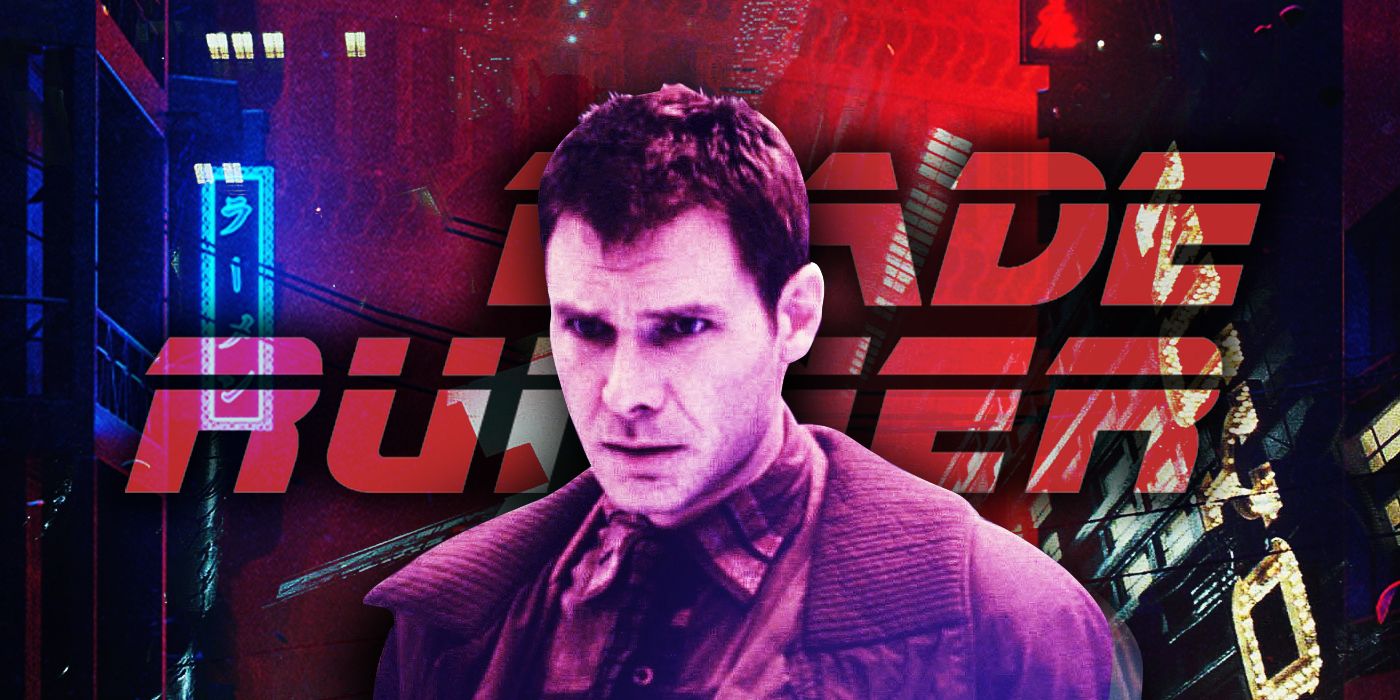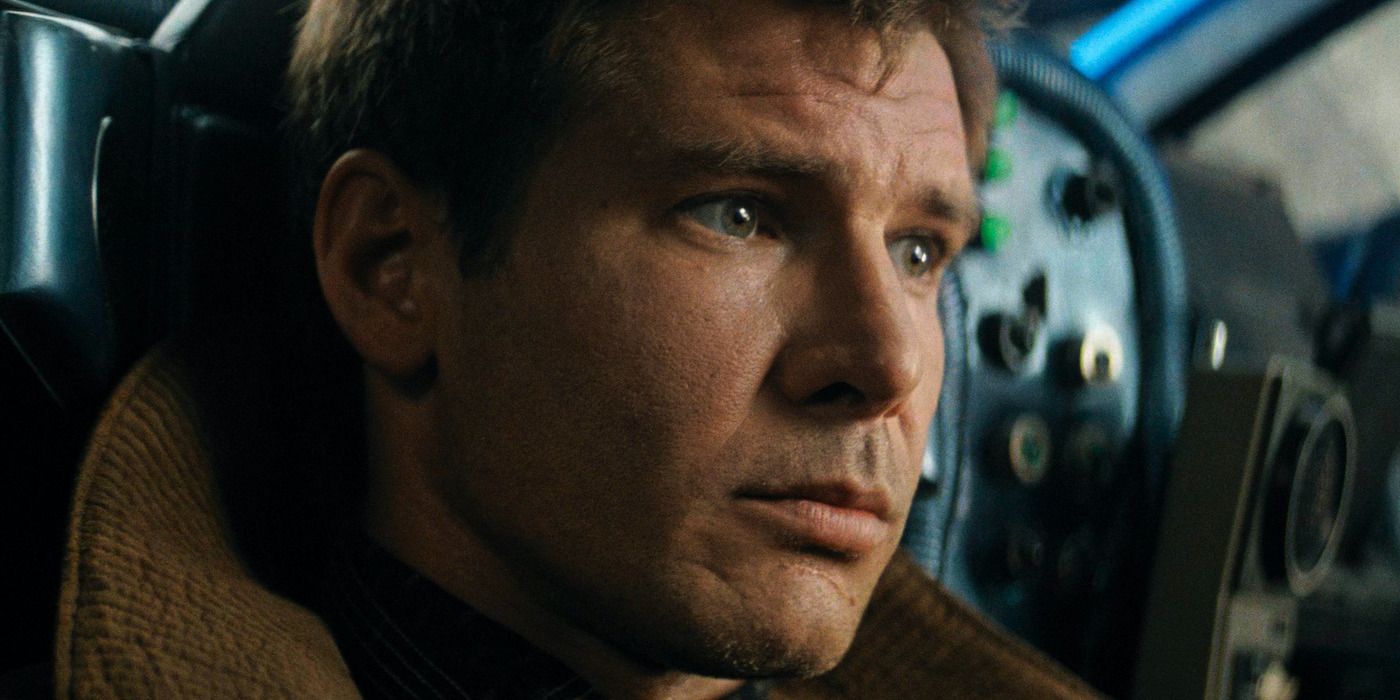As Ridley Scott's Blade Runner turns 40 today, it's tempting to focus on those things its imagined 21st Century society didn't get right: flying cars, life-like androids, and off-world colonies are markedly absent from our everyday lives. Yet the visionary brilliance of Scott, realized in conjunction with a production team that included "visual futurist" Syd Mead, lies in the technological details and philosophical problems it predicts for the future. While you might not be jumping into a flying car anytime soon, if you've edited a digital image, worked from home, or undergone psychometric testing in the last few years, you've experienced your own bit of Blade Runner.
Set in Los Angeles, 2019, Rick Deckard (Harrison Ford) is tasked with killing four replicants, androids who have escaped from an off-world colony. His investigation brings him into contact with Dr Eldon Tyrell (Joe Turkel) and his assistant, Rachael (Sean Young), a replicant with human memories. As Deckard confronts the lead fugitive, Roy Batty (Rutger Hauer), he comes to understand the line between human and non-human is not clear-cut. It's a line we still see wrestled with in media today.
Blade Runner is one of those films from the late 70s and early 80s that radically re-imagined how a science fiction world should look. The sterile sets of earlier efforts such as Logan's Run gave way to the "lived in" look of Star Wars, with its battered machinery and grimy locations. Scott's own Alien was a key film in this development. Set on board the Nostromo, a spaceship towing an ore refinery, it brought a suitably industrial aesthetic to the future. The high-tech suspension pods and ship's computer (associated with the company) exist alongside living quarters filled with junk (associated with the working-class crew). Made in 1979, Alien is still a compelling vision of a future where business interests dictate how we travel to the stars.
Scott carries a few elements from Alien into Blade Runner, such as the Nostromo's flight navigation graphics on the LAPD “spinner,” suggesting the two films happen in a similar reality. However, Alien unfolds mainly in the self-contained world of the Nostromo, while Blade Runner comes with the challenge of realizing an entire city. For this, Scott and team employ a retro-futurist design, with art deco and film noir elements playing alongside giant video screens and a multicultural sprawl. It’s a smog-filled and rain-drenched city, clearly suffering from the effects of environmental disaster, that is by turns overcrowded and depopulated. A lot of people have obviously taken the offer (blasted out across the city from floating billboards) to “begin again” on the off-world colonies. Advertising is everywhere, using key products at the time of production (most famously Atari and Coca-Cola) to give a heightened sense of verisimilitude.
In this degraded landscape the interiors are equally significant, depicting the isolation of individuals from one another as well as society. Tyrell, whose fortune is based on replicant labor, resides in a penthouse filled with gilded eagles and classical busts, suggestive of a Roman emperor in his decadence. Meanwhile, the compassionate genetic designer, J.F. Sebastian (William Sanderson), lives in a deserted apartment block crumbling from the damp. Yet it’s Deckard’s apartment that is the most important and cleverly designed location in the film.
Barely illuminated by lamps and the glow of screens, Deckard lives in a jumble of the old and new. His kitchen and bathroom are cluttered with devices. The lounge and bedroom teem with monitors that have set-top boxes, cameras, and digital readouts attached. There’s the sense of technology multiplying, even as the physical environment decays. Scott anticipated the look of our current homes and the way devices attract add-ons to enhance user experience. Screens are omnipresent in Blade Runner, from the noirish office of Police Chief Bryant (M. Emmet Walsh) to every room in Deckard’s home, predicting our current focus for work and entertainment. They might be the boxy CRT monitors of 1982 rather than the tablets and phones of today, but the ubiquity of screens is predicted well.
Alongside the pile-up of technology, Deckard’s place is densely populated with books and old photographs. Key moments in the film happen at an antique piano. Some of this reflects the concerns of the Philip K. Dick, whose source novel Do Androids Dream of Electric Sheep? was radically changed for the film adaptation. Dick’s futuristic heroes are attracted to anachronisms such as records, paperbacks, and ceramics. In the book, Deckard is obsessed with getting an electric sheep as a pet, reflective of a world where animals are rare due to extinction. The effect elicits a sense of future nostalgia and characters yearning for a better time.
Technology is all-encompassing in Blade Runner, but there’s an equal push to hold onto the vestiges of the old as a means of retaining humanity. The photographs in the film are related to memory, one of its key themes. Rachael has implanted human memories as part of Tyrell’s effort to make replicants more compliant. While the famous unicorn dream sequence occurs when Deckard sits at the piano contemplating old family pictures (perhaps wondering if they’re really his), the observant will notice one of Rachael’s photographs come to life for a split second as he holds it in an earlier scene. Dreams, memory and reality are pliable in the film, in the manner of modern digital technologies.
One of Blade Runner’s most accurate predictions actually occurs around photographs, reflective no doubt of the filmmakers’ knowledge of their medium and where it was headed. As part of his investigation, Deckard feeds a photograph into one of his multi-purpose monitors. He then manipulates the image, dividing it into a grid, panning and zooming, even going so far as to probe a mirror shown in an adjoining room. Futuristic technology at the time of release (not least because of the voice control Deckard uses), it’s a clunky depiction of the photo editing software we now carry on our phones. However, the scene is most interesting in its suggestion of images as data, infinitely open to examination and manipulation. In contrast to the aged physical photos, the digital image has such high resolution that it can reveal secrets and supplant the intent of the original. Another key aspect is the location in which Deckard’s work takes place… not in the LAPD office or a suite of computers, but sitting on a sofa in his own home.
Ultimately, the most engaging piece of technology in Blade Runner is the Voight-Kampff machine used to detect replicants. We first see it being employed by another blade runner, Dave Holden (Morgan Paull), who looks and speaks uncannily like Deckard. When the movie found its second life in the 1990s (thanks to renewed interest from the release of Blade Runner: The Director’s Cut) such details fed the question, “Is Deckard a replicant?” However, that seems of surface level concern in a film that suggests the measure of a human is acting with human compassion. Accordingly, Voight-Kampff is a form of psychometric test, specifically designed to assess empathy. Challenging hypothetical situations are thrown at the subject with the aim of measuring automatic physical responses, such as dilation of the iris and fluctuating heartbeat. With their (supposed) lack of emotion, replicants betray themselves through an absence of disgust or embarrassment.
While we don’t have the problem of tracking replicants in our current society, most employees (especially those in large corporations or “knowledge” industries) will feel a twinge of familiarity here. In the decades since Blade Runner's release we have been probed and tested for personal traits, usually in the name of productivity or team development. The Meyers-Briggs Personality Test is one of the oldest and most ubiquitous, and no doubt familiar to anyone who has worked in an office for a period of time. More modern psychometric tests, posing hypotheticals with a choice of unappealing options that force subjects to reveal hidden preferences, are now commonly used in workplace recruitment and development. The internet abounds with articles about how to “survive” such psychometric testing. It would be nice to think that somewhere in the fictional Los Angeles of 2019 a piece is being written: “How to ace your Voight-Kampff test.”
“Quite an experience to live in fear, isn't it?” Batty tells Deckard at the end of the film. “That’s what it is to be a slave.” While we don’t witness the brutality of the off-world colonies, we see how the replicants are treated on earth as malfunctioning items of technology. Yet the fugitives are a rejection of the idea that a worker is something to be quantified, utilized, and disposed of when the task is complete. Despite his murderousness, Batty becomes an affirmation of human values when (in his dying moments) he chooses to save Deckard, even though the blade runner no longer has utilitarian value (because the job is done). In an age when people are pushing back against the relentless drive for productivity, seeking a rebalancing of priorities, Blade Runner’s underlying concerns about the commodification of the worker take on an even greater relevance.
After four decades, Blade Runner remains one of cinema’s most potent visions, made by filmmakers committed to depicting a future that was plausible. Viewers continue being fascinated by this world, flocking to see Denis Villeneuve's sequel Blade Runner 2049. As is often the case in science fiction, it’s the underlying ideas within this film and this franchise inspiring the technological details that have proven most accurate. And it’s those elements that will compel audiences to return to this classic time and time again.


.jpg)
